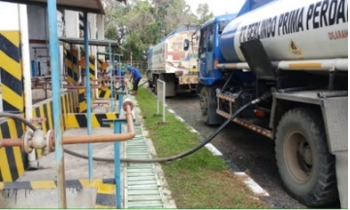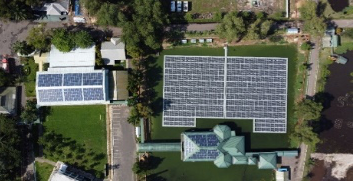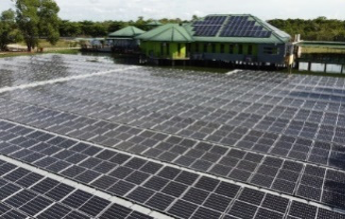Environment
Under the Environmental Pillar, AEI understands the importance of managing the environmental impacts of our business. AEI's dedication to preserving the environment in order to maximize added value for stakeholders and the environment is reflected in our commitments to manage our emissions, energy performance, water usage, and land management. The focus areas under this Strategy Pillars are: ‘Managing our GHG and Energy Performance’, ‘Minimizing Direct Environmental Impact’, and ‘Conserving Ecological Function’.
Emissions
We are committed to reduce GHG emissions from our business and are actively participating in the national and global agenda towards climate change, including the acceleration of cleaner energy provision. We are accelerating our transition and diversification plans to secure business resilience and maintain long-term stakeholder value in the face of climate adversity. The plan includes our initiatives to reduce GHG emissions from our operations and expand our portfolio in renewable energy, water, and green minerals as our “New Engines” under the Adaro Green and Adaro Minerals pillar. AEI also aims to increase the efficiency of our operations and reduce our energy consumption, while maintaining our production levels.
To manage our GHG emissions from energy usage, AEI has issued an Energy and Greenhouse Gas Policy to be implemented across all subsidiaries. The implementation of this policy is carried out through target setting on energy management. AEI through AI and SIS have acquired and kept the ISO 14001:2015 certification, the most recent version of the environmental management standard. AI adopted ISO 50001 to the Energy Management System and has developed and improved our Energy Performance Indicator (EnPI), Energy Baseline (EnB), and Energy Conservation Opportunity List (ECO List).
Carbon Abatement Roadmap Development
In 2022, AEI began developing a Carbon Abatement Roadmap to ensure our readiness to achieve sustainable growth. AEI explored carbon abatement opportunities through techno-economic and commercial analysis of every possible initiative, as well as their alignment with our business aspirations. We have assessed our four subsidiaries’ roadmap toward a low-carbon future, namely for Adaro Indonesia, Maritim Barito Perkasa (MBP), Makmur Sejahtera Wisesa (MSW), and Saptaindra Sejati (SIS). Based on the subsidiaries we have assessed, AEI will adopt the best-available technologies in low-carbon fuels and operations, renewable energy provision, and carbon sequestration to keep on track with the pathway toward a low-carbon future. In 2023, we will continue our journey to assess and develop our other subsidiaries’ roadmap
Exploring Nature based Solutions
Two companies under the Adaro Land segment hold business permits for the utilization of carbon sequestration and/or storage. This project is divided into two areas, PT Alam Sukses Lestari (Barito Lestari Forest Restoration Project-BLFRP) with ±19.520 Ha of the concession area and PT Hutan Amanah Lestari (Barito Lestari Peatland Project-BLPP) with ±25.804 Ha of the concession area.
In 2022, these subsidiaries commenced the development of a Project Design Document (PDD) to identify estimated emission reductions or removal from the concession areas. The initiatives will generate an average carbon credit claim of ~1.3M of tCO2e per annum for the next 10 years and 2.4M of tCO2e per annum for the next 30 years (with a peak of 2.7M tCO2e per annum for 5 years).

Low Carbon initiatives and Energy Transitions
At AEI, we comply with the Ministry of Energy and Mineral Resources’ regulation No.12/2015 regarding the use of biodiesel fuel, by implementing B30 initiatives since 2020 for our mining and logistics business operations. For the further initiatives, we aim to use B35 and gradually increase the use of FAME.

AEI has installed 130 kWp of Solar Rooftop PV, and another 468 kWp of Floating PV (FPV), the first and one of the largest installed FPV in Indonesia. The project is expected to generate up to 749,294 kWh/year and serves a captive market to support AEI’s mining operation.


WATER AND WASTE MANAGEMENT
Our Water Management
We are aware that water and wastewater management is important to protect natural resources. Managing water withdrawal could maintain the water balance. Along with maintaining water withdrawal, we are also aware that responsible water consumption can realize sustainable water resources.
Managing water resources must also be complemented with the compliance of water discharge against quality standards. Improper management of water could lead to water scarcity and cause an unbalanced natural ecosystem. Apart from the impact on the natural ecosystem, there will be potential impacts on the social landscape with any mismanagement in this area, such as infringing on the right to clean water.
Our waste management
We handle our operational solid waste according to its category, including organic, inorganic, residue, and hazardous (B3) waste. In managing solid waste, both hazardous waste and non-hazardous waste, AEI puts forward the 3R (Reduce-Reuse-Recycle) concept.
We realize that waste management is an integral part of environmental management. We carry out initiatives such as the utilization of organic waste as community livestock feed, waste composting as fertilizer for reclamation plants, and remaining solid waste that can still be used for operations is reused, whereas inorganic solid waste and residue that cannot be entirely utilized are sent to the landfill. AEI collects and monitors waste-related data using an online database inventory, named Adaropedia.
AEI manages hazardous waste by storing it in an authorized temporary hazardous waste storage location, before being transferred by an authorized third party in line with the applicable laws and regulations. There were no recordings of spillages during the reporting year. In addition, no waste was dumped into any waterbody.
BIODIVERSITY AND LAND MANAGEMENT, RECLAMATION & REHABILITATION
AEI recognizes the importance of ecological functions and biodiversity in sustaining our operations and contributing to the health and wellbeing of the communities and ecosystems we operate in. Our approach to managing these critical aspects is aligned with our commitment to sustainable development and is embedded in our corporate management framework.
We have established policies to ensure that our operations are conducted in an environmentally responsible and sustainable manner. We carry out the conservation in various ways, including:
- Developing sustainable biodiversity strategies, plans, and programs
- Identifying biological resources in operational areas
- Determining species that will be protected or preserved
- Identifying processes and categories of activities that have or are expected to have a significant impact on biodiversity
- Regularly monitoring and supervising the species and biodiversity
- Increasing the biodiversity status of the species that have been determined as important biological resources by conducting continuous reviews and improvements on our biodiversity protection programs.
We ensure compliance with relevant environmental laws and regulations and conduct regular internal and external audits to identify and address areas for improvement. Biodiversity management and monitoring are carried out in reclaimed operational areas or areas that are currently in the reclamation stage, as well as in the Paringin biodiversity zone. Through reclamation, we expect to maximize the development potential of post-mining areas, as is in the case of the Paringin biodiversity zone.
We recognize the importance of stakeholder engagement and collaboration in managing ecological function and biodiversity. We engage with local communities, government agencies, and other stakeholders to understand their concerns and expectations related to these aspects and work collaboratively to address them.
At AMI, in addition to AMI's mining policy which prioritizes environmental protection and maintenance, the entire Coal Contracts of Work (PKP2B) has rich flora and fauna species, which encourages AMI to carry out intensive biodiversity management. AMI conducts periodic monitoring every semester carried out by third parties. To monitor the presence of diversity in the PKP2B area, employees and work partners also conduct Biodiversity Observations (OKEHATI) throughout the year.
The Biodiversity Management Plan (BMP) preparation method is carried out in a descriptive-qualitative manner and uses an analytical approach that integrates data such as data from studies that have been conducted (EIA 2006, Social Economic Baseline Study 2006 and 2008, Social Economic Opportunity Assessment of the Lampunut Project 2015, Report on Management and Monitoring Environment 2009-2022, and OKEHATI independent monitoring report) and data obtained directly such as limited discussions with stakeholders and field surveys.
We are committed to continuous improvement in managing ecological functions and biodiversity. We monitor our performance through regular environmental audits, ecological monitoring, and stakeholder feedback.
